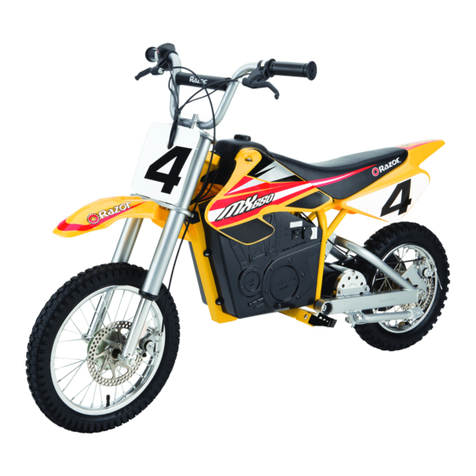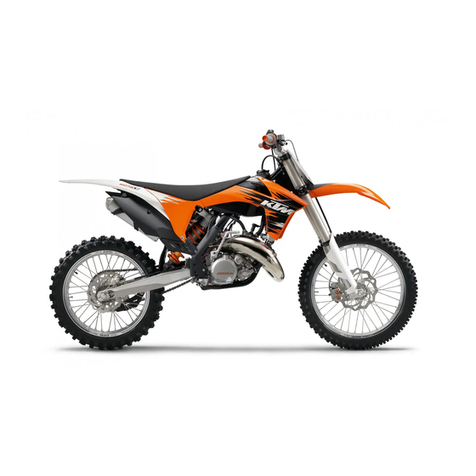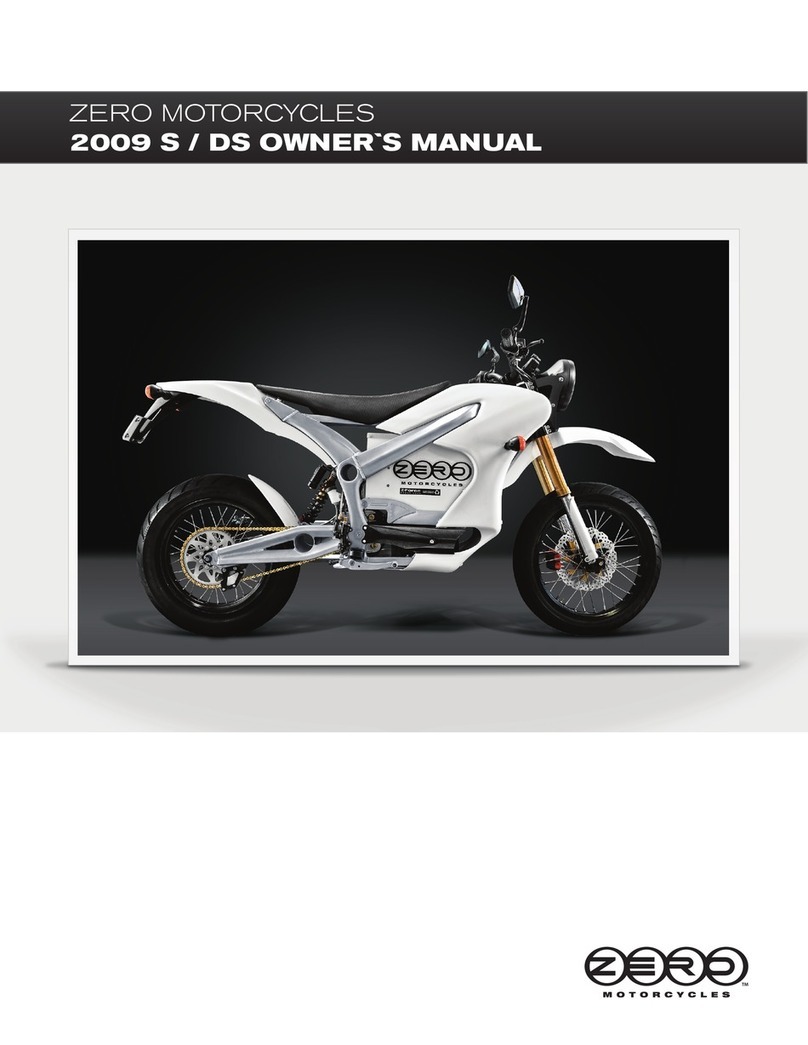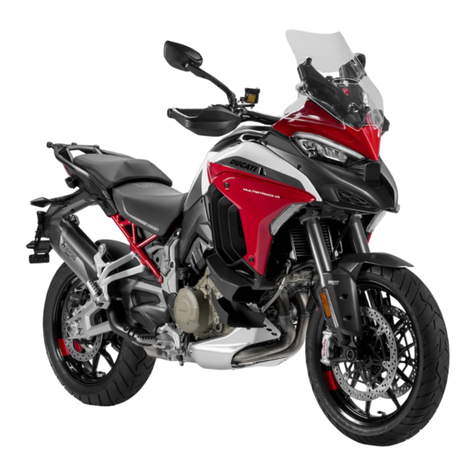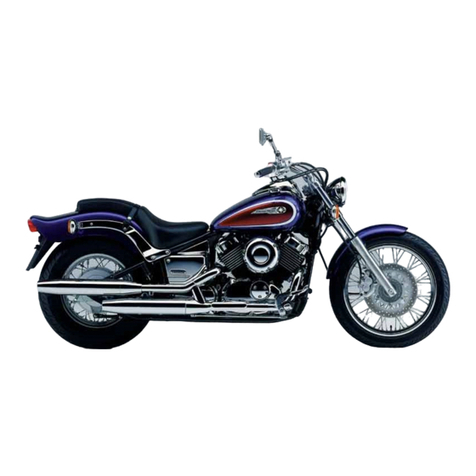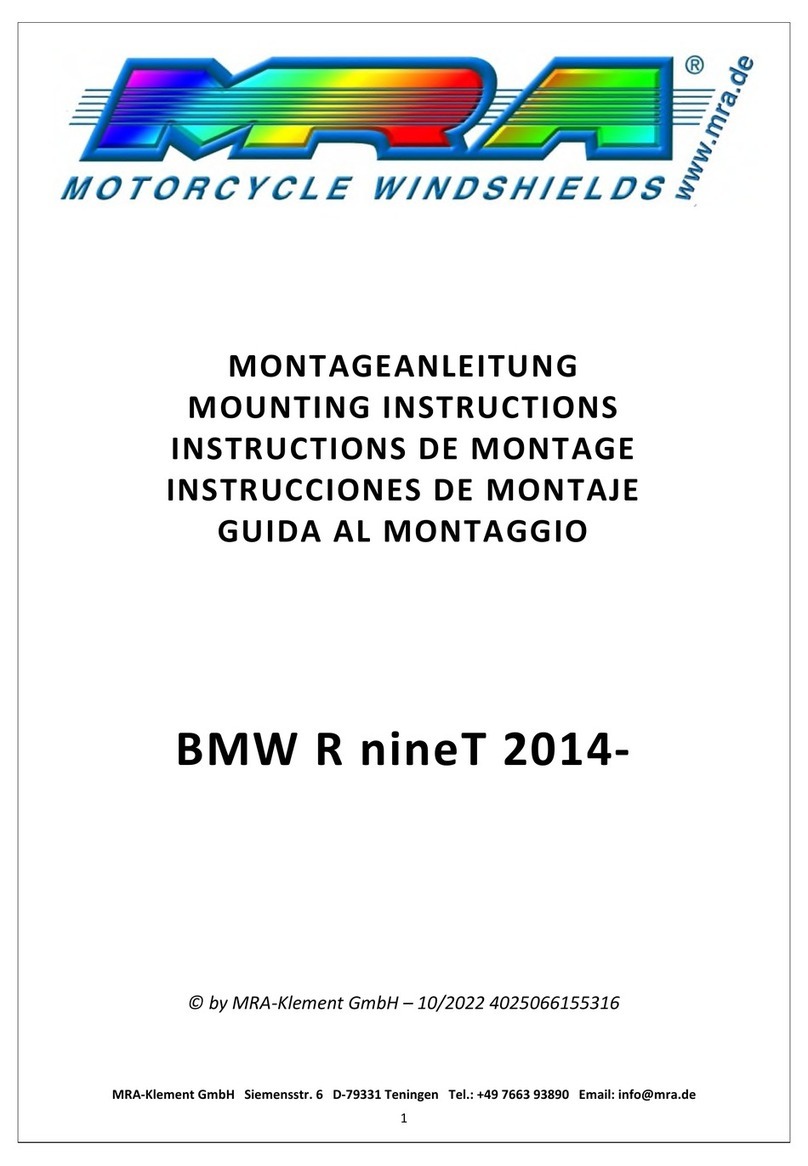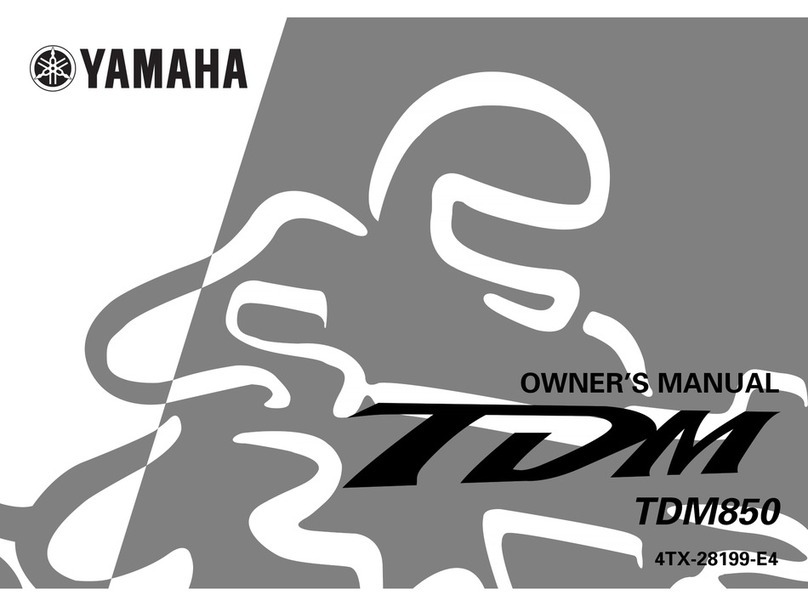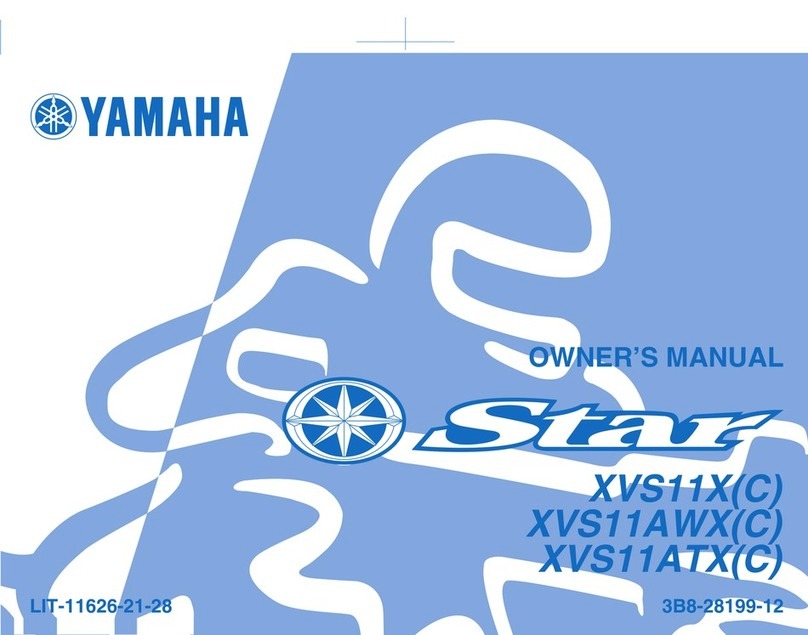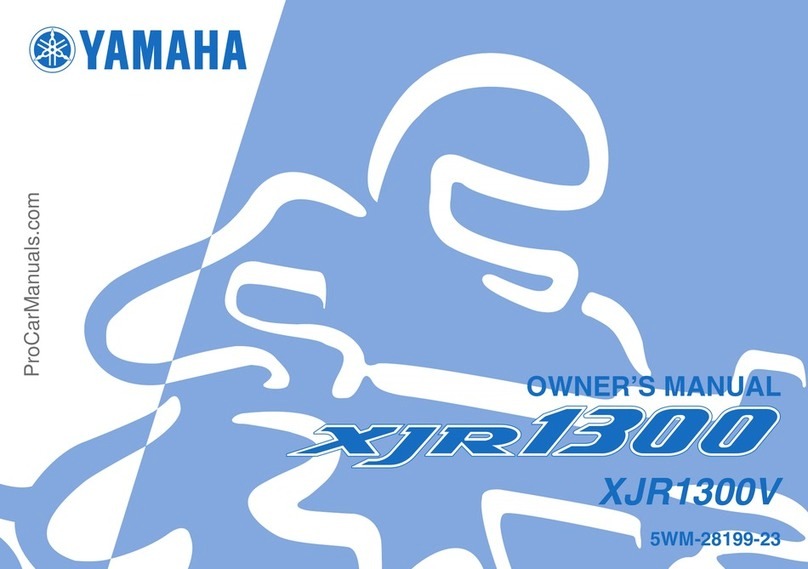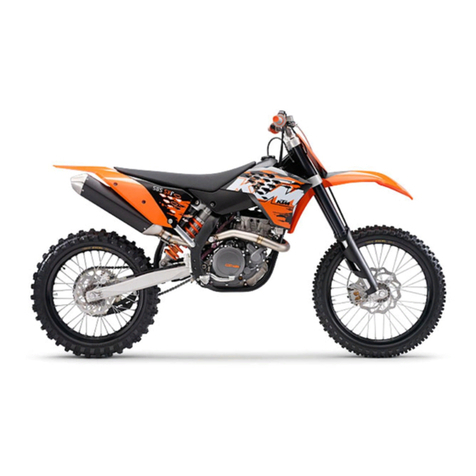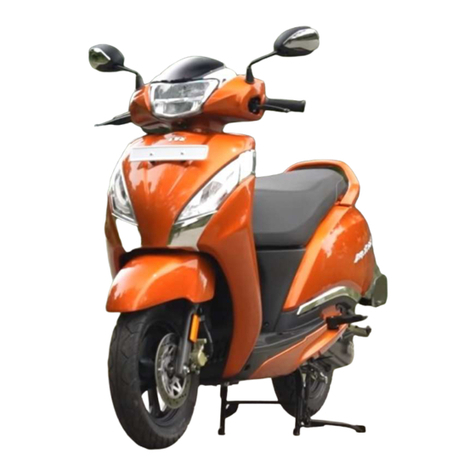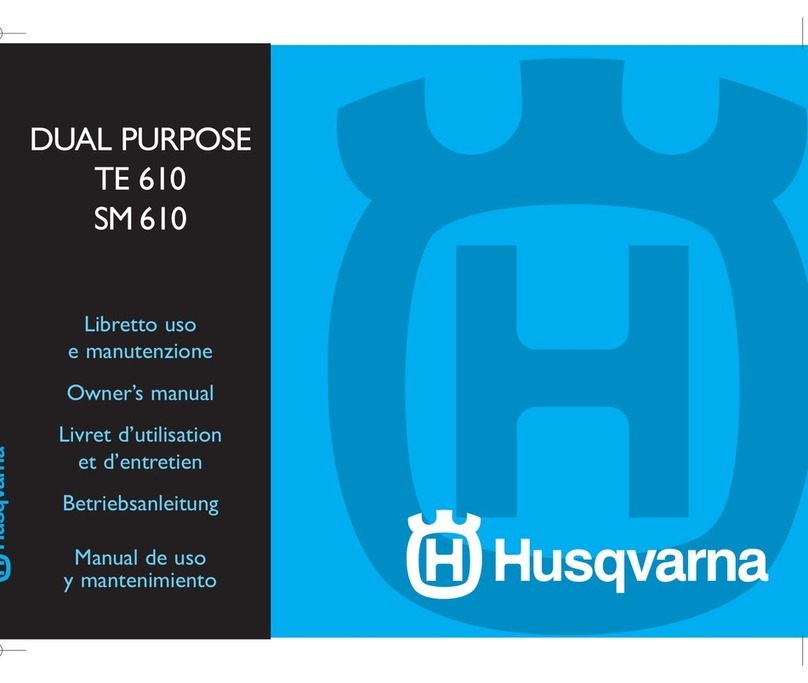PEUGEOT KISBEE 50 2021 User manual

KISBEE &
STREETZONE
.3("$#Ŕ43(+(2 3(.-2$1Ŕ2, -4 +


Notice d'utilisation
Owner's manual
Bedienungsanleitung
Libretto d'istruzioni
Manual de utilización
Gebruikershandleiding
ǼīȋǼǿȇǿǻǿȅȋȇǾȈȉǾ
Instruktionsbok
Manual de proprietàrio
Käyttöohjekirja
Instruktionsbog
FR
GB
DE
GR
IT
ES
NL
DK
PT
FI
SE


Reproduction or translation, even partial, is forbidden without the written consent of Peugeot Motocycles 1/20
FR
GB
DE
IT
ES
NL
GR
SE
PT
FI
DK
CONTENTS
Information .................................................................. 2
Safety advice............................................................... 2
Characteristics............................................................ 3
Vehicle identification .................................................. 7
Products to use ........................................................... 7
Information about the instructions ........................... 8
Description of the vehicle .......................................... 9
Instruments ............................................................... 10
Controls ..................................................................... 11
Key-operated ignition switch functions.................. 11
Checks to perform before use ................................. 12
Advice for starting up and driving .......................... 12
Warning ..................................................................... 12
Eco mode .................................................................. 12
Driving on flooded roads ........................................... 12
Inspection before setting off ...................................... 13
Starting the engine .................................................... 13
Driving ....................................................................... 13
Braking ...................................................................... 14
Fuel supply ................................................................ 14
Running in the engine ............................................... 14
Switching off the engine and parking ........................ 14
Service operations.................................................... 15
Maintenance advice .................................................. 15
Environment / Recyclable.......................................... 15
Switching off the engine and parking ........................ 14
Spark plug inspection or replacement....................... 15
Checking the engine oil level..................................... 16
Changing the engine oil............................................. 16
Draining the relay box................................................ 17
Replacing the air filter................................................ 17
Throttle cable play ..................................................... 17
Tyres.......................................................................... 18
Brake inspection........................................................ 18
Battery....................................................................... 19
Fuses.......................................................................... 20
Bulb replacement...................................................... 20
Headlight adjustment ............................................... 20

2/20 Reproduction or translation, even partial, is forbidden without the written consent of Peugeot Motocycles
FR
GB
DE
IT
ES
NL
GR
SE
PT
FI
DK
INFORMATION
You have just bought a Peugeot vehicle.
We would like to thank you for purchasing one of our
products.
Please take some time to read this manual carefully
before using the vehicle.
This user manual should always be kept in the boot of the
vehicle. It contains instructions for use, checks and
maintenance of the vehicle, and important safety
instructions intended to protect the user and third parties
against accidents.
It will give you plenty of advice on how to keep your
vehicle in full working order.
Your authorised dealer is familiar with all the vehicle's
characteristics and has genuine spare parts and specific
tools. He can advise you and service your vehicle in the
best conditions according to the established service
schedule to ensure that you can enjoy driving it in
complete safety.
This manual must be considered as an integral part of the
vehicle and must remain with it even if the vehicle is sold
on.
PEUGEOT MOTOCYCLES is constantly improving its
vehicles. It therefore reserves the right to remove, modify
or add any reference mentioned.
SAFETY ADVICE
A inexperienced motorcyclist should make himself
completely familiar with his vehicle before going out in
traffic. You are strongly advised not to lend your vehicle
to an inexperienced rider.
To ride a motorbike, you are required by law to hold a
licence or to have completed specific training with a
professional, depending on the applicable legislation and
based on its category.
Wearing an approved helmet and gloves is obligatory for
the user and passenger. You are also advised to wear
goggles and light-coloured or reflective clothing adapted
to motorcycling.
In some countries, the applicable legislation may not
authorise transportation of a passenger, and elsewhere
it may oblige motorcycle users to contract a civil liability
insurance policy to protect third parties and the
passenger against potential damage resulting from an
accident.
Driving whilst under the influence of alcohol, drugs or
certain medicines is inexcusable and dangerous for
yourself and others.
Excessive speed is an important factor in many accidents.
You must observe the road signs and signals and adapt
your speed to the weather conditions.
The engine and the exhaust system components can
reach very high temperatures. When parking your
vehicle, be careful to avoid contact with inflamable
materials which could cause a fire or with parts of the
body which could result in serious burns.
Luggage carriers and paniers approved by PEUGEOT
MOTOCYCLES are available as options (depending on
the model). The assembly instructions must be complied
with and the maximum permissible load (3 to 5 kg
depending on the equipment) must not be exceeded.
Fitting accessories such as the driver's apron, top-case,
etc. may affect the vehicle's stability (wind factor, load,
etc.).
When riding the vehicle fitted with accessories, the driver
should reduce speed.
Mounting adaptable parts that have not been approved by
PEUGEOT MOTOCYCLES, which alter the technical
characteristics or performances of the vehicle is
forbidden. Any modification will invalidate the warranty
and the vehicle will no longer be in compliance with the
version approved by the appropriate services.

FR
GB
DE
IT
ES
NL
GR
SE
PT
FI
DK
Reproduction or translation, even partial, is forbidden without the written consent of Peugeot Motocycles 3/20
CHARACTERISTICS
STREETZONE
45 km/h
STREETZONE
25 km/h
KISBEE 50
45 km/h
KISBEE 50
25 km/h
Official type-approval code. K1AANA K1ABNA K1AAMA K1ABMA
Dimensions in mm
Weight in kg
Unladen weight. 92
In working order. 97
Authorised maximum. Total weight of the
vehicle, the user, the passenger, the
accessories and luggage.
260
665
1256
1160
1850

FR
GB
DE
IT
ES
NL
GR
SE
PT
FI
DK
4/20 Reproduction or translation, even partial, is forbidden without the written consent of Peugeot Motocycles
CHARACTERISTICS
STREETZONE
45 km/h
STREETZONE
25 km/h
KISBEE 50
45 km/h
KISBEE 50
25 km/h
Official type-approval code. K1AANA K1ABNA K1AAMA K1ABMA
Engine
Identification. B1E40QMB-B
Engine type. 4-stroke single-cylinder
Cubic capacity. 50 cc
Bore x stroke in mm. 39 x 41.4 mm
Maximum power. 2.6 kW at 7700 rpm
Maximum torque. 3.2 Nm at 7300 rpm
Cooling. By forced-air circulation
Fuel supply. Direct electronic injection (EFI)
Spark plug. NGK CR7HSA
Lubrication. Pressurised wet sump lubrication
Exhaust. Catalysed and lambda sensor
Anti-pollution standard. Euro 5
Consumption a.
a. These consumption values are established according to the regulation 134/2014 Annex VII. They may vary according to driving beha-
viour, traffic conditions, weather conditions, the load in the vehicle, vehicle maintenance and use of the accessories...
1.75 l/100 2.55 l/100 1.75 l/100 2.55 l/100
CO2emission (On cycle). 41 g/km 59 g/km 41 g/km 59 g/km
Capacities in litres
Engine oil. 0.8
Relay box oil. 0.12
Fuel tank. 6.3
Fork oil. 0.043

FR
GB
DE
IT
ES
NL
GR
SE
PT
FI
DK
Reproduction or translation, even partial, is forbidden without the written consent of Peugeot Motocycles 5/20
CHARACTERISTICS
STREETZONE
45 km/h
STREETZONE
25 km/h
KISBEE 50
45 km/h
KISBEE 50
25 km/h
Official type-approval code. K1AANA K1ABNA K1AAMA K1ABMA
Tyre dimensions
Front. 120/90 - 10 110/70 - 12
Minimum load index and speed rating. 37B
Rear. 120/90 - 10 110/70 - 12
Minimum load index and speed rating. 50B
Pressure in bars
Front. Solo. 1.3 1.6
Pillion. 1.3 1.6
Rear. Solo. 1.6 1.8
Pillion. 1.8 2
Suspension
Front. Upside down telescopic front fork Ø27 mm
Travel: 73 mm
Ø27 mm telescopic fork
Travel: 68 mm
Rear. 1 Shock absorber
Travel: 68 mm
Brakes
Front. 1 disc Ø190 mm 1 disc Ø170 mm
Rear. 1 drum Ø110 mm

6/20 Reproduction or translation, even partial, is forbidden without the written consent of Peugeot Motocycles
FR
GB
DE
IT
ES
NL
GR
SE
PT
FI
DK
CHARACTERISTICS
STREETZONE
45 km/h
STREETZONE
25 km/h
KISBEE 50
45 km/h
KISBEE 50
25 km/h
Official type-approval code. K1AANA K1ABNA K1AAMA K1ABMA
Electrical equipment
Headlights. 12V - 35/35W (HS1)
"Side light" bulbs. LED
Indicator bulbs. 12V - 10W
Rear light. 12V - 21/5W
Number plate light. 12V - 5W
Battery. 12V - 6Ah Maintenance-free batteries
YUASA YTX7A-BS

Reproduction or translation, even partial, is forbidden without the written consent of Peugeot Motocycles 7/20
FR
GB
DE
IT
ES
NL
GR
SE
PT
FI
DK
VEHICLE IDENTIFICATION
A.Manufacturer's plate.
B.Vehicle identification number (V.I.N).
C.Engine number.
D.Tyre pressure label.
The label affixed under the saddle gives the cold tyre
pressures when riding alone and with a passenger.
PRODUCTS TO USE
Temperature variations modify tyre
pressure.
The tyre pressure must be checked once
a month when cold.
B
A
D
C
Lead-free petrol
Engine oil 4 stroke
SAE 5W40 Synthetic API SL/SJ
Relay box oil
SAE 80W90 API GL4
Brake fluid
DOT 4
Fork oil
Hydraulic oil 10W

8/20 Reproduction or translation, even partial, is forbidden without the written consent of Peugeot Motocycles
FR
GB
DE
IT
ES
NL
GR
SE
PT
FI
DK
INFORMATION ABOUT THE
INSTRUCTIONS
Specific information is indicated by the following symbols:
Möbius band
Recyclable.
Means that the product or the package can be
recycled.
Explosive
The product may explode upon contact with a
naked flame, spark or static electricity,or due
to the effect of heat, an impact or friction.
Handle and keep away from heat sources and
other causes of sparks.
Flammable
The product may ignite in contact with a naked
flame, a spark or static electricity, or due to
the effect of heat, friction, in contact with the
air or in contact with water, releasing
inflammable gases.
Handle and keep away from heat sources and
other causes of sparks.
Corrosive
The product is corrosive.
It can attack (corrode) or destroy metals.
Contact with the product or splashes of the
product may burn the skin and cause lesions
to the eyes. Avoid any contact with the eyes
and skin. Do not inhale.
Harmful to health
The product can be poisonous in high doses.
It may irritate the skin, eyes and airways.
It may cause skin allergies.
It may cause drowsiness or dizziness. Avoid all
contact with the product.
Toxic or fatal
The product can rapidly be fatal.
It poisons rapidly, even at low doses. Wear
protective equipment.
Avoid any contact (oral, skin, inhalation) with
the product and wash all exposed areas
carefully after use.
Harmful for the environment
The product pollutes.
It has a harmful effect (in the short and/or long
term) on organisms in aquatic environments.
Do not dispose of it in the environment.
Do not throw away into a garbage can
One of the product's component is toxic and
can be hazardous to environment. Do not
throw the used product in the dustbin. Take it
back to the trader or to a specific waste
disposal site.
People's safety
Operation that can be dangerous for people.
People's safety can be seriously affected if the
recommendations are not fully respected.
Important
Operation that can be hazardous to the
vehicle.
Indicate the specific procedures that shall be
followed in order not to damage the vehicle.
Note
Gives key information concerning operation of
the vehicle.

Reproduction or translation, even partial, is forbidden without the written consent of Peugeot Motocycles 9/20
FR
GB
DE
IT
ES
NL
GR
SE
PT
FI
DK
DESCRIPTION OF THE VEHICLE
1. Instrument panel
2. Utility hanger
3. Battery / Fuses
4. Fuel tank
5. Kick starter
6. Central stand
7. Folding footrests
8. Brake levers
9. Throttle
10. Ignition switch
11. Brake fluid level
12. Engine oil level
13. Grab handle
7
5
8
4
13 9
11
1
12
6
10
8
7
2
3

10/20 Reproduction or translation, even partial, is forbidden without the written consent of Peugeot Motocycles
FR
GB
DE
IT
ES
NL
GR
SE
PT
FI
DK
INSTRUMENTS
Instrument panel Kisbee
1 - Speedometer
- Double-scale speedometer showing kilometers and
miles.
2 - Milometer
3 - Direction indicator warning light
4 - Emissions control system failure warning light
5 - Fuel gauge
6 - Main beam control
Instrument panel Streetzone
1 - Speedometer
2 - Fuel gauge/Fuel reserve gauge
• 1st level: the two segments flash.
• 2nd level: the last segment flashes.
When the tank is empty, all the segments on the fuel
gauge are off and the "pump" symbol flashes (p).
If all the segments flash, the diagnostic function has
detected an anomaly on the fuel gauge system. The
system must be checked by an authorised dealer.
3 - Min. oil level indicator
• If the oil indicator flashes or stays on, top up the oil in
the oil tank.
4 - Emissions control system failure warning light
5 - Milometer/Tripmeter (TRIP).
- The tripmeter displays and stores the number of
kilometres travelled by the vehicle. The machine total
kilometres remains in the memory when the battery is
disconnected.
- The tripmeter displays and stores the number of
kilometers travelled during a given period.
Changing from the total distance display to the daily
distance display
- With the ignition on, switching from the total distance
display to the daily distance display and vice-versa is
done by briefly pressing the control button (A).
Resetting the tripmeter
- The daily counter is reset by pressing more than
3 seconds on the control button (A).
6 - Main beam control
If the warning light flashes quickly, there
is a fault in the direction indicators.
If the indicator light turns on when riding,
you are advised to have the vehicle
checked by an authorised dealer.
3 41 2
5
6
When the fuel tank is full all the
segments of the fuel gauge are
lit.
The fuel reserve gauge
corresponds to the two last
segments (r) which show two
reserve levels.
1 27
A 456
3 3
r
p
If the warning light flashes quickly, there
is a fault in the direction indicators.
If the indicator light turns on when riding,
you are advised to have the vehicle
checked by an authorised dealer.

Reproduction or translation, even partial, is forbidden without the written consent of Peugeot Motocycles 11/20
FR
GB
DE
IT
ES
NL
GR
SE
PT
FI
DK
7 - Maintenance indicator
- The maintenance indicator appears on the display
each time the service recommended by the
manufacturer is due.
Maintenance counter reset.
- Ignition off, hold down the control button (A) and turn
on the ignition, the distance unit flashes
- Release the settings button.
- Hold down the settings button for more than 5 seconds
to switch off the maintenance symbol and set the
maintenance counter to zero.
- Turn off the ignition.
CONTROLS
1. Dipped lights/Headlights switch
The dipped lights/headlights switch has 3 functions:
a. Dip beam
b. High beam
c. Flashing the lights. (Passing)
2. Horn switch
3. Indicators switch
To indicate a change of direction, press the switch:
• Either to the right.
• Or to the left.
To stop the indicators flashing, press the switch.
4. Starter switch
KEY-OPERATED IGNITION SWITCH
FUNCTIONS
A.The engine is off. Power to the electrical circuit is off.
The key can be removed.
B.Power to the electrical circuit is on. The engine can be
started. The lighting is switched on. The key cannot be
removed.
C.Power to the electrical circuit is off. The handlebars are
turned to the left. Steering can be locked. The key can
be removed.
D.Action of the key in this position allows you to open the
saddle with a cable device.
Maintenance frequency
5000 km
You are advised to go to an authorised
dealer to have the vehicle serviced and
the message on the maintenance
indicator erased.
PASSING
1
2
3
b
a
c
4
P
U
S
H
I
G
N
I
T
I
O
N
B
A
D
C
OPEN

12/20 Reproduction or translation, even partial, is forbidden without the written consent of Peugeot Motocycles
FR
GB
DE
IT
ES
NL
GR
SE
PT
FI
DK
CHECKS TO PERFORM BEFORE USE
The user must personally ensure that his vehicle is in
good condition. Certain safety elements may show signs
of damage even when the vehicle is not used. e.g.
prologned exposure to bad weather can lead to oxidation
in the braking system or a pressure drop in the tyres
which can have serious consequences. In addition to a
simple visual inspection, it is extremely important to
check the following points before use.
If one if the elements in the checklist does not work
properly, ask your registered dealer to check it and have
it repaired if necessary before using the vehicle.
ADVICE FOR STARTING UP AND DRIVING
WARNING
Before using the vehicle for the first time, make sure you
are familiar with all the controls and their respective
uses. If you are not sure about the functions of any of the
controls, your registered dealer can answer your
questions and give you any help you may require.
ECO MODE
Adopt smooth driving behaviour
- Turn the acceleration handle gradually, not suddenly.
- Anticipate braking using the engine brake.
- Limit the vehicle load as well as aerodynamic
resistance.
- Regularly check the inflation pressure in your tyres,
and refer to the label under the seat.
- Avoid heating up the engine while stationary: the
engine heats quicker when you drive.
- Have your vehicle serviced according to the
manufacturer's maintenance plan.
These attitudes contribute to economising fuel
consumption, reducing CO2 emissions and
alleviating the background sound of traffic.
DRIVING ON FLOODED ROADS
If you cannot avoid driving through flood water:
- Check that the water depth does not exceed 100,
taking into account waves which could be generated
by other road users.
- Under no circumstances exceed a speed of 10 km/h.
- Once out of the flooded area, brake gently several
times to dry out the brakes as soon as the safety
conditions allow it.
These checks only take a few minutes
and help to keep your vehicle in good
condition, for optimum use combining
reliability and safety.
As exhaust fumes are toxic, the engine
must be started in a well-ventilated area.
It must never be allowed to run in a
closed space, even for a short time
You are strongly advised not to drive on
flooded roads as this may seriously
damage the engine, transmission and
electrical systems on your vehicle.
10 km/h - 6 mph MAX
100 mm

Reproduction or translation, even partial, is forbidden without the written consent of Peugeot Motocycles 13/20
FR
GB
DE
IT
ES
NL
GR
SE
PT
FI
DK
INSPECTION BEFORE SETTING OFF
STARTING THE ENGINE
For greater safety, place the vehicle on its central stand
before starting the engine.
• Turn the ignition key to "ON".
• Ensure that the throttle is in the OFF position.
• Press one of the brake levers while pressing the starter
button. Do not press the starter for more than
10 seconds.
• Release the starter button as soon as the engine starts.
To kick start, place the vehicle on its central stand.
• Turn the ignition key to "ON".
• Ensure that the throttle is in the OFF position.
• Grip the grab handle with your right hand.
• Operate the kick-start until the engine starts.
DRIVING
Starting off
The vehicle is on its stand with the engine running.
• Squeeze the brake lever with your left hand, grip the
grab handle with your right hand and push the vehicle
forwards to fold up the central stand.
• Sit on the vehicle.
• Release the left brake and turn the throttle slowly with
your right hand to start moving.
Accelerating and decelerating
To accelerate, turn the throttle towards (A). To slow down,
turn the throttle towards (B).
Component Checks
Fuel
• Check the fuel level in the tank.
• Top up with fuel if necessary.
• Check that there is no fuel leak.
Engine oil
• Check the level of the engine oil.
• If necessary, top up with the
recommended oil.
Disk brakes
• Check brake operation.
• Have an approved dealer check
them if they feel soft.
• Check brake pad wear.
• Check the level of brake fluid in
the reservoir.
Drum brakes
• Check brake operation
• If necessary adjust the control
• Check the wear on the brake
linings
• Correct if necessary
Lighting,
signalling,
indicators, horn
• Check operation.
• Correct if necessary.
Wheels and tyres
• Check the tyre wear and condition.
• Check the tyre pressures cold.
• Correct if necessary.
Throttle
• Check the throttle handle turns
smoothly and returns correctly to
its starting position.
Steering • Check the free rotation of the
steering.
Stand • Check that the central stand can
be unfolded smoothly.
If the engine does not start, release the
starter button and the brake lever, wait a
few seconds and try again.
B A

14/20 Reproduction or translation, even partial, is forbidden without the written consent of Peugeot Motocycles
FR
GB
DE
IT
ES
NL
GR
SE
PT
FI
DK
BRAKING
The right lever controls the front brake and the left lever
controls the rear brake.
For good braking, it is very important to coordinate the
following actions:
• Close the throttle.
• Operate the left and right brake levers simultaneously
and slowly increase the pressure.
Braking suddenly on a wet road or in a bend should be
avoided.
Reduce speed on steep slopes to avoid prolonged
braking, as overheating will reduce braking efficiency.
FUEL SUPPLY
A label affixed near the fuel cap reminds you of the type
of fuel to use.
The fuel tank is located under the saddle.
- Place the vehicle on the central stand.
RUNNING IN THE ENGINE
Running in the engine is essential to guarantee its
performance and lifetime.
During the running-in period, you are advised not to
overload the engine and to avoid exceeding a higher
than normal operating temperature.
From 0 to500 km.
Do not hold the throttle handle open at more than half its
distance of travel over a long trip.
From 500 to1000 km.
Do not hold the throttle handle open at more than 3/4 its
distance of travel over a long trip.
Once this mileage has been done, the vehicle can be
used normally.
SWITCHING OFF THE ENGINE AND PARKING
The engine is switched off when at idling speed by turning
the ignition key to "OFF".
Place the vehicle on its central stand on flat ground.
Each time the vehicle is parked, the steering should be
locked and the ignition key removed.
Using only one brake reduces braking
efficiency and can lock the wheel,
causing a fall.
The engine must be switched off in order
to fill the fuel tank in complete safety.
When filling up with fuel, ensure the end
of the nozzle is correctly inserted into the
filling orifice on the fuel tank.

Reproduction or translation, even partial, is forbidden without the written consent of Peugeot Motocycles 15/20
FR
GB
DE
IT
ES
NL
GR
SE
PT
FI
DK
MAINTENANCE ADVICE
Ensure that the servicing schedule for your vehicle is
strictly followed to maintain your contractual warranty
rights.
A table of inspections for the maintenance schedule is
inserted into the maintenance booklet. The registered
dealer must add his stamp, the date of servicing and the
number of kilometres the vehicle has covered.
In order to maintain maximum safety and reliability of
your vehicle, you are advised to have maintenance
and repairs carried out by a registered dealer who
has the necessary technical training, specific tools
and spare parts.
ENVIRONMENT / RECYCLABLE
Worn parts replaced during routine maintenance
(mechanical parts, battery, etc.) must be disposed of
with specialised bodies.
At the end of its life, the vehicle must be taken to an
authorised centre for recycling.
In all cases, comply with the local laws.
CLEANING THE VEHICLE
Wash the bodywork with soapy water and rinse with
generous amounts of clear water.
The vehicle can be dried with a chamois leather. After
washing the vehicle, brake several times at low speed to
dry out the brakes.
Certain silicon-based products can alter the quality of the
paintwork. In case of need or doubt, a registered dealer
can advise you on using cleaning products or restoring
scratched bodywork.
SPARK PLUG INSPECTION OR REPLACEMENT
The engine must be cold.
• Remove the spark plug access hatch.
• Remove the saddle storage compartment.
• Disconnect the suppressor.
• Remove the spark plug.
• Measure the distance between the electrodes and
correct it if necessary (A).
• Fit and screw in the spark plug manually.
• Tighten the spârk plug with a spanner.
• 1/8 - 1/4 turn for a reused spark plug.
• 1/2 turn for a new spark plug.
SERVICE OPERATIONS
Batteries contain harmful substances.
They must be disposed of according to
the legal requirements and must under
no circumstances be thrown away in the
household waste.
The bodywork is made of plastic parts
that can be painted or are shiny. Do not
use solvents or cleaning products that
are too corrosive.
Do not use high pressure cleaners
which may cause water to infiltrate the
following parts: seals, bearings and
hinges, electrical components such as
connectors, contactors and lighting.
The vehicle should be washed in a place
equipped for wastewater collection
It is essential to use a resistive spark
suppressor and a resistive spark plug in
accordance with the manufacturer's
recommendations.
Spark plug Electrode gap
NGK CR7HSA 0.6 to 0.7 mm
Ensure the suppressor is correctly
clipped onto the spark plug.
Have the torque quickly checked by a
registered dealer.
A
A

16/20 Reproduction or translation, even partial, is forbidden without the written consent of Peugeot Motocycles
FR
GB
DE
IT
ES
NL
GR
SE
PT
FI
DK
CHECKING THE ENGINE OIL LEVEL
- Place the vehicle on its central stand on flat ground.
- Start the engine, let it run for a few minutes and then
stop it.
- Wait a few minutes for the oil to stabilise.
- Remove the cap/oil gauge (1).
- Wipe the cap/gauge and reinsert it into the filling orifice
without screwing it up.
- Remove the filler cap/gauge and check the oil level.
- The oil level shall not be between the minimum (A) and
maximum (B) level marks without exceeding the latter.
- Add oil if necessary.
CHANGING THE ENGINE OIL
The engine must be drained when it is warm to allow the
oil to run easier.
- Place the vehicle on its central stand on flat ground.
- Put on protective gloves.
- Remove the drainage cap and its seal (2) and allow
the oil to drip into a recipient.
- Remove the strainer cap (3) and clean the strainer (4).
- Check and clean the strainer.
- Put back the drainage cap and strainer cap, fitted with
a new seal.
- Pour the required quantity of oil corresponding to the
manufacturer's standards into the filler hole.
- Start the engine and let it run for a short while.
- Add oil if necessary.
- Check that the oil drain plug is sealed.
The engine oil level should always be
checked before you leave.
B
A
1
We advise you to go to a registered
dealer for draining.
Oil contains substances which are
harmful to the environment. Your dealer
is equipped to dispose of used oil without
endangering the environment and in
compliance with current standards.
XXXXXX-X
*
XXXXXXXX
*
2
Engine oil
SAE 5W40 Synthetic API SL/SJ
Quantity
0.8 L.
4
3
This manual suits for next models
5
Table of contents
Other PEUGEOT Motorcycle manuals

PEUGEOT
PEUGEOT METROPOLIS 2019 User manual

PEUGEOT
PEUGEOT SPEEDFIGHT 2021 User manual
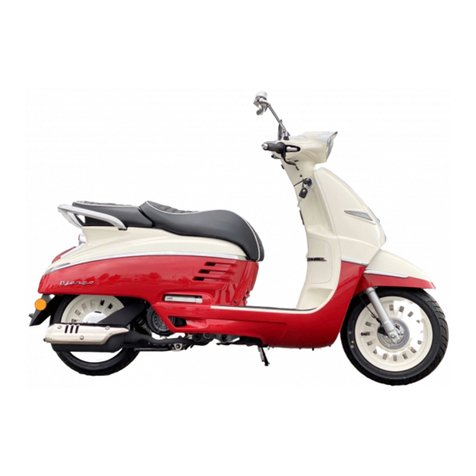
PEUGEOT
PEUGEOT DJANGO 50 2021 User manual
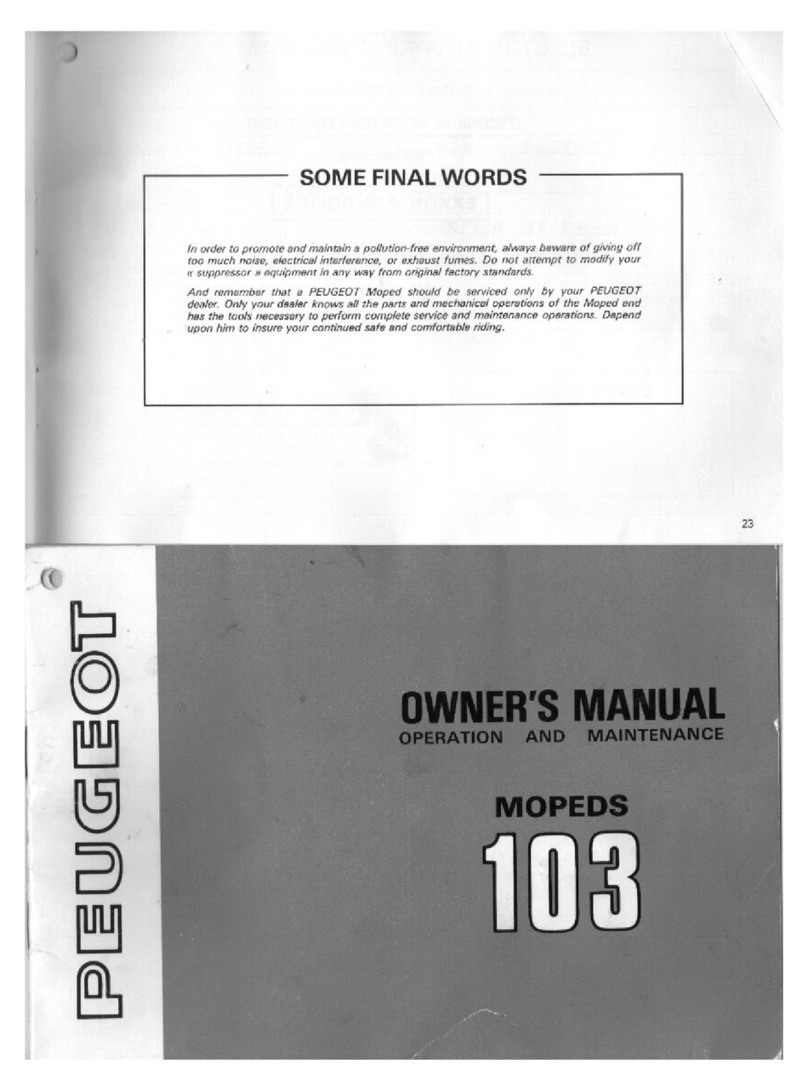
PEUGEOT
PEUGEOT 103 LS-U1 User manual

PEUGEOT
PEUGEOT METROPOLIS ABS 2021 User manual

PEUGEOT
PEUGEOT TWEET 50 2021 User manual

PEUGEOT
PEUGEOT 103 LS-U1 User manual
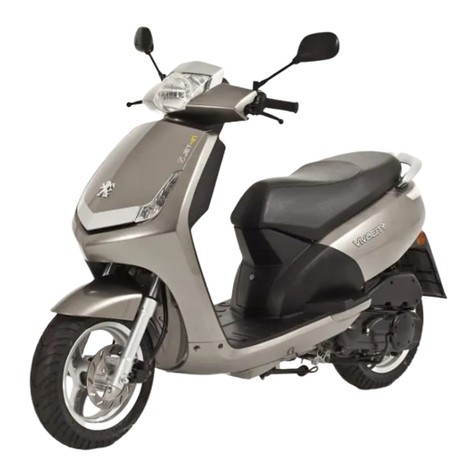
PEUGEOT
PEUGEOT Vivacity 50 CC 2 Stroke Installation guide

PEUGEOT
PEUGEOT 103 LS-U1 User manual

